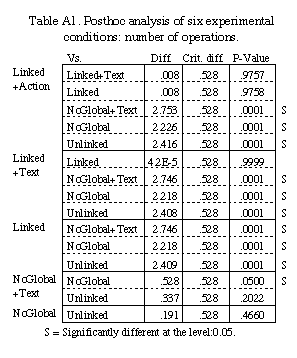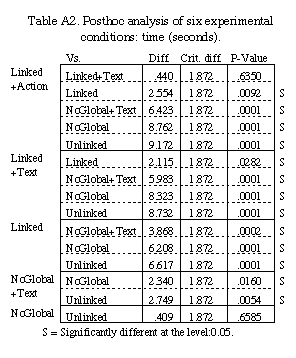Yamaashi, K., Cooperstock, J., Narine, T. & Buxton, W. (1996). Beating
the limitations of camera-monitor mediated telepresence with extra eyes,
Proceedings
of CHI '96, ACM Conference on Human Factors in Computing Systems, 50-57.
Beating the Limitations of Camera-Monitor Mediated Telepresence with
Extra Eyes
| Kimiya Yamaashi 1 |
Jeremy R. Cooperstock 2,4 |
Tracy Narine 2 |
William Buxton 2,3 |
| 1 Hitachi Research Laboratory |
2 Telepresence Project |
3 Alias|Wavefront |
| Hitachi Ltd. |
University of Toronto |
110 Richmond Street East |
| 7-1-1 Omika-cho Hitachi-shi |
10 King's College Road |
Toronto ON M5C 1P1 |
| Ibaraki-ken 319-12 Japan |
Toronto ON M5S 3G4 Canada |
Canada |
| +81 294 52 5111 |
+1 416 978 0703 |
+1 416 362 8558 |
| yamaashi@hrl.hitachi.co.jp |
{jer, tracyn}@dgp.toronto.edu |
bbuxton@aw.sgi.com |
ABSTRACT
In physical presence, you are most aware of your immediate surroundings,
such as what is at your feet or who is beside you, and less aware of objects
further away. In telepresence, almost the opposite is true. Due to the
nature of the medium, you are most aware of what is in front, often at
a distance, as dictated by the limited view of the camera. Even where remote
camera control is possible, the range of exploration is limited and the
logistics of control are typically awkward and slow. All of this adds up
to a pronounced loss of awareness of the periphery in telepresence.
The research described here attempts to compensate for these problems
through two mechanisms. First, we provide telepresence users with two separate
views, one wide-angle and the other, a controllable, detailed view. To
simplify navigation, the two views are seamlessly linked together, so that
selecting a region of one will have an effect in the other. Second, we
utilize sensor information from the remote location to provide the user
with notification of relevant events that may require attention. Together,
these tools significantly enhance users' awareness of their telepresence
surroundings.
Keywords
Telepresence, teleconferencing, CSCW, multimedia
INTRODUCTION
Normal human vision can be conceived as consisting of two highly mobile
cones of view. One is the focused foveal cone, one degree wide, while the
second is the peripheral cone, or global field of view, spanning approximately
170 degrees [1]. Excellent spatial resolution is provided by the first,
while the second, lower resolution view, provides us with stimulus that
acts to redirect our attention.
Camera-monitor mediated vision, in contrast, suffers in resolution and
due to the size of the display, uses limited azimuth of the visual field.
Watching television, for instance, typically involves the foveal cone only.
The narrow channel of information, both in the sense of bandwidth and field
of view, imposes limitations on the ability to explore, follow conversations,
check reactions, and generally sense significant actions in a remote space,
such as people passing by or entering. In such situations, users must choose
between a global and a focused view. With the former, resolution is sacrificed
to permit a wide field of view and easy change of gaze direction. If only
the focused view is provided, users obtain details but no peripheral awareness.
This is typical of most videoconference settings [5] [11].
One approach to support both the foveal and peripheral cones is with
multiple views. The problems with this approach are well understood. The
Multiple Target Video (MTV) system of Gaver et. al. [12] first proposed
the use of multiple cameras as a means of providing more flexible access
to remote working environments. Users were offered sequential access to
several different views of a remote space. However, as the authors noted,
a static configuration of cameras will never be suitable for all tasks.
Furthermore, switching between views introduces confusing spatial discontinuities.
A further study (MTV II) by Heath et. al. [15] attempted to address this
latter issue by providing several monitors, so that every camera view was
simultaneously available. While this new configuration was more flexible,
the inability of static cameras to provide complete access to a remote
space still remained a problem. Furthermore, the various views were independent
of one another, and the relationship between them was not made explicit.
Consequently, spatial discontinuities persisted.
Another approach involved the Virtual Window concept [10], which
uses the video image of a person's head to navigate a motorized camera
in a remote location. Our user experience with this technique [7] revealed
a significant improvement to the user's sense of engagement in meetings.
Unfortunately, when the camera was focused on a small area, the loss of
global context often made the user unaware of important activity taking
place out of view.
To compensate for the limitations on vision imposed by camera-monitor
mediated telepresence, the work discussed here offers to:
-
Provide both a global (peripheral) and a detail (focused) view, simultaneously.
We note that this approach has already been used extensively in the Ontario
Telepresence Project [2] [3] [17] by combining the two views through a
picture-in-picture device. The same approach with multiple views was also
proposed by Kuzuoka et. al. [16]. However, as will be discussed later,
providing a link between the two views is not only critical for usability,
but also supports the goal of multiple views while avoiding the pitfalls
of spatial discontinuities inherent in the MTV studies [12] [15].
-
Provide a navigation mechanism using these views, allowing users to redirect
their view in both direction and scale, through a simple user interface.
However, even with these two goals satisfied, the user is still sensorally
deprived to the extent that it may inhibit social interaction. Therefore,
our third goal is as follows:
-
Provide a sensory surrogate or prosthesis to compensate for the limited
scope of visual information.
SUPPORTING FOVEAL AND PERIPHERAL CONES
It has been suggested by several vision researchers that a brain mechanism
exists to drive foveating saccades 1
of the eye in response to stimulus in the periphery region [14] [19]. In
the discussion of their model of saccadic eye movement, Tsotsos et al.
comment that these saccades play an important role in the exploration of
the visual world [18]. Supporting evidence for this comes from neurophysiology.
A region known as PO, which receives a representation of the periphery
of the visual field, has been identified in the brains of primates [4].
Deprived of this information, individuals suffering from tunnel vision,
or a loss of vision outside the fovea, exhibit severe problems navigating
through their physical surroundings, even when these surroundings are familiar
to them [13]. With this in mind, it becomes readily apparent that camera-monitor
mediated telepresence is bound to suffer unless peripheral vision can be
supported concurrently with a detailed, foveal view.
Overlaid Multiple Views
As an initial attempt to provide this support, we developed a prototype
system, consisting of a large and small display, as shown in Figure 1.
The large screen display provides the user with a wide angle view of the
remote space while the small display provides a high resolution view of
the area of interest. With the camera orientations fixed and the proper
geometric positioning of the two displays, spatial discontinuities are
minimized. The sensation of increased peripheral awareness obtained by
this system is very powerful.
We note that this prototype requires two high-resolution displays,
one of them quite large, in order to achieve a significant effect. As this
may be prohibitively expensive for most videoconference users, we would
like to unify the two views into a single display. Unfortunately, even
with a large screen display, the limited resolution would make the quality
of the foveal region unacceptable. Another approach is required.

Disjointed Multiple Views
Another approach to supporting both the foveal and peripheral views is
to display the two separately on the same screen. Since the views are disjointed,
each can have sufficient size and resolution, even with the limitations
of current technology. Our implementation of this system is shown in Figure
2. The top portion of the display provides a foveal or detail view, obtained
from a user-controlled motorized camera, while the lower portion provides
the peripheral or global view from a fixed, wide-angle camera.
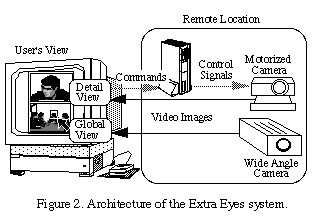
Since the views are independent of each another, there is no consistent
geometric relationship between the two. This can result in an inability
to locate the position of the detailed region within the peripheral view,
once more bringing us back to the problem of spatial discontinuities. Navigation
under these conditions is typically difficult and slow. This is especially
severe when the scene being viewed is relatively homogeneous (e.g. through
tele-education, a large class of students). Normal human vision does not
suffer from this problem because the direction of the fovea explicitly
dictates the peripheral view.
Linking Multiple Views
To address the lack of a geometric relationship between the two views,
we indicate the detailed region within the global view by means of a yellow
bounding box (detail frame), as shown in Figure 3. The enclosed region
corresponds exactly to what is displayed in the detail view. As the detail
view changes, the bounding box on the global view adjusts accordingly.
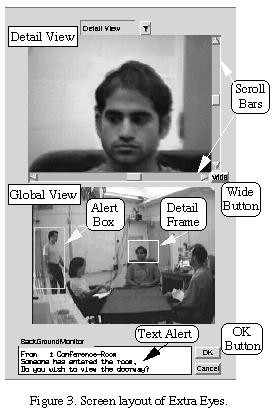
Because the two views are logically linked, users can select a desired
region by sweeping out a bounding box or simply point-and-click on
the global view. In the former case, the detail view is defined by
the size of the bounding box, while in the latter, the detail view is centered
at the selected position and displayed at the maximum zoom. These interaction
techniques with the global view permit a far more efficient navigation
mechanism than the effectively blind 2
view selection offered by both the original MTV system [12] and the Virtual
Window system [10].
In addition to control via the global view, the detail view can
be manipulated directly through the scroll bars, which provide tilt and
pan control of the motorized camera. It is also possible to adjust the
zoom factor of the detail view by pressing the left or right mouse button,
or obtain a wide view by selecting the wide button.
To provide a linkage between the global and detail views, we require
a mapping between the coordinate systems of each, dependent on the properties
of the different cameras. We first define a global coordinate system, which
covers the entire area visible to both cameras. Next, we define models
for each camera, which consist of a view model, and in the case of the
motorized camera, a transformation function. The models describe the relationship
between pixel coordinates of each camera and the global coordinate system.
In the case of our fixed wide-angle camera, this is simply a one-to-one
mapping. The transformation function for the motorized camera maps pixel
coordinates to the appropriate motor signals. The models and relationships
are described in Figure 4.
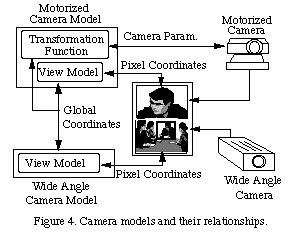
When a user selects an area of the global view, the pixel coordinates
of this region are first translated into global coordinates through the
wide angle view model, and then the global coordinates are mapped into
camera parameters via the transformation function. Finally, the camera
parameters are sent to the detail camera. At the same time, the updated
location and dimensions of the bounding box are computed, and displayed
on the global view. Similarly, when a user specifies an area of the detail
view directly, the pixel coordinates of this region are transformed into
motor signals for the camera, and to global coordinates describing the
new bounding box.
SENSORY SURROGATE
Sensory surrogate for environmental awareness
There exists no substitute for physical presence that offers the fidelity
of rapidly directable stereo vision and spatially sensitive binaural audio,
as manifested by the human senses. To help bridge the gap between physical
presence and telepresence in this regard, our Extra Eyes system provides
users with a sensory surrogate to increase their awareness of the
remote environment. The surrogate monitors background information obtained
by sensors and reports on relevant events through the use of sound, text,
and graphics, or a combination of the three. In this manner, background
processing by the computer is used to improve the user's foreground awareness.
Sensors in the room [6] monitor the status of presentation technology
such as the VCR, document camera, and digital whiteboard, as well as the
entry of new individuals as depicted in Figure 5. When an event occurs,
it triggers an
alert-action sequence. The alert corresponds to the
screen message displayed (e.g. "Someone has entered the room. Do you wish
to view the doorway?"), as well as the appearance of a blue bounding box
(alert box) in the corresponding region of the global view, as shown
in Figure 3. If the user acknowledges the alert by pushing the OK
button or selecting the
alert box, then an appropriate action is
executed by the system (e.g. control the motorized camera to display the
doorway). Another possible alert message is "The VCR is now playing. Do
you wish to view the tape?" with the associated action of switching the
user's view to the VCR output.

Sensory surrogate for social awareness
We have also applied the sensory surrogate concept to increasing social
awareness among individuals sharing the media space of the Ontario Telepresence
Project [17]. The Postcards system (see Figure 6), based on Rank Xerox
EuroPARC's Portholes [8], captures snapshots from each user's office at
set intervals and distributes these to members of the media space. A sensory
surrogate in the Postcards system compares every two consecutive frames
from each office to determine if there is activity there. This is done
by counting the number of pixels that have changed by more than a certain
threshold amount between the two frames. Although the algorithm is susceptible
to false detection of activity due to camera perturbations, it has worked
reasonably well in our environment. Stored knowledge of activity allows
Postcards to determine whether individuals are in or out, or have recently
entered or vacated their offices.
Users can take advantage of this background monitoring feature
by asking the system to sense activity and notify them when any
number of individuals are simultaneously present in their offices. This
permits informal group meetings to be established with a minimum of effort,
freeing the user from the mundane task of repeatedly checking to see who
is available.

EVALUATION
User Study
We evaluated the performance of Extra Eyes through the following user study.
Three television monitors were arranged in a remote location, as shown
in Figure 7. Letters of the alphabet were displayed on a randomly chosen
monitor, one at a time. The user's task was to use the Extra Eyes system
to identify these letters as they appeared, as quickly as possible, while
minimizing the number of errors. Each letter would remain on the monitor
until the user had identified it, by typing its corresponding key. Once
the letter was identified, it would be replaced by another letter on a
different monitor. The font size was sufficiently small so that a zoom
factor near the maximum was required for legibility. We tested each of
our seven subjects on the following conditions, the order being randomly
varied, with 20 repetitions per condition:
-
No Global: Only the detail view is visible. This situation is equivalent
to typical telepresence systems.
-
No Global + Text: Same as 1. In addition, a text alert indicates
the display on which the current letter appears.
-
Unlinked: Both the global and detail views are simultaneously visible,
but the two views are not linked (i.e. neither view has effect on the other).
This is equivalent to the MTV system.
-
Linked: Both the global and detail views are simultaneously visible
and linked.
-
Linked + Text: Same as 4. In addition, a text alert indicates the
display on which the current letter appears.
-
Linked + Action: Same as 5. In addition, an alert box appears,
and the user can invoke the action corresponding to the alert by pushing
the OK button or by clicking anywhere within the alert box.
The action causes the camera to point directly to the new letter with maximum
zoom factor.
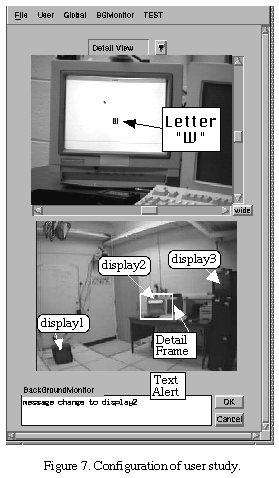
Discussion and results of user study
For the first three conditions, users exhibited two strategies to identify
the various letters. When no information beyond that of the detail view
was available, users consistently zoomed out to obtain a wide angle view,
then panned and tilted the camera to center the letter, before zooming
in again. This zoom-out strategy, represented by the solid line
in the space-scale diagram [9] of Figure 8a, requires over three camera
operations, on average, to identify each letter. When an alert message
was added, indicating the display on which the new letter appears, users
tended to change their strategy. Knowing the approximate location of the
desired monitor from past experience gathered during the study, users often
tried to find this monitor by repeatedly panning and tilting the camera,
as shown by the solid line in Figure 8b. This strategy is quite similar
to searching for an object in a familiar room, while in the dark. Because
users cannot accurately select a desired position with the
pan-tilt
strategy, this method often requires more operations than the
zoom-out
strategy. The same pan-tilt strategy was used when the global view
was provided, but not linked to the detail view. For the remaining three
conditions, users were able to identify the letters with only a single
camera operation.

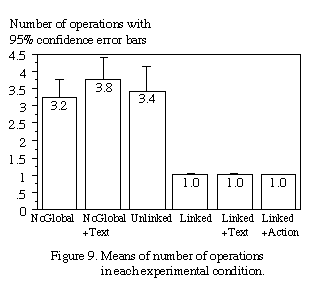

Figure 9 and Figure 10 present the results of our user study, indicating
the average number of camera operations users required to identify each
letter, as well as the average completion time with 95% confidence error
bars, with each of the six experimental conditions.
Analysis of variance (ANOVA) showed that both number of operations
and trial completion times were significantly affected by the experimental
conditions. For number of operations, F(5, 30)=55.2, p<0.001. For completion
time, F(5, 30)=40.1, p<0.001.
As measured by number of operations (Table A1 in the Appendix),
Fisher's protected LSD posthoc analyses showed that all linked conditions
were significantly different from the Unlinked and NoGlobal conditions
(p<0.05). However, there is no significant difference among linked conditions.
The difference between Unlinked and NoGlobal, as well as Unlinked and NoGlobal+Text
is also insignificant.
As measured by completion times (Table A2 in the Appendix), Fisher's
protected LSD posthoc analyses showed that all conditions were significantly
different from each other (p<0.05), except Linked+Action vs. Linked+Text
condition (p=0.64) and NoGlobal vs. Unlinked (p=0.66).
Based on these results, we can draw the following conclusions.
Conclusion 1: Linkage between views is very important
When the two views were linked, navigation in the remote environment via
selection in the global view was effortless. Any desired (visible) target
could be selected directly with a single camera operation, as indicated
by the dashed lines of Figures 8a and 8b (see also Figure 9). In this case,
the previous indirect strategies of zoom-out and pan-tilt,
which require almost twice as much time as direct selection, were never
used. Users expressed their opinion that the direct selection mechanism
was more natural than the indirect methods. Indeed, all linked conditions
were significantly better than the unlinked one in terms of both number
of operations and trial completion time.
Further user feedback was also highly informative. Some commented that
the detail frame was useful as an indication of direction of camera
motion. Furthermore, when the two views were not linked, users had to remain
conscious of their current position in order to reach the desired view.
This was a result of spatial discontinuities [12]. Linkage between the
two views reduced the effect of these discontinuities, because a user action
on one view has a direct effect on the other.
Conclusion 2: Sensory information is useful
The time improvement from linked views to linked views with a text alert
(p<0.05, see Table A2) indicates the added value of sensory information.
As most users explained, the alert allowed them to reduce the size of the
visual
search area. Users also appreciated the audio feedback of a beep,
provided simultaneously with an alert message, indicating that a new letter
was about to appear.
We note that sensory information may have compensated for the
low update rate (approximately 1-2 frames/s in our present implementation)
of the global view. In many instances, the indication of various alerts
preceded the appearance of a new letter on the global view by one second
or more. This enabled users to begin their navigation toward the desired
monitor before the letter was actually visible.
Although the differences in time and number of operations between
Linked+Text and Linked+Action were not statistically significant, users
indicated that the graphic alerts were more useful than text messages.
The graphic alerts completely specify the relevant visual regions, as opposed
to text alerts, which require the user to read and then perform a search.
Many users simply did not read the text alerts, preferring instead to watch
only the graphics display.
FURTHER ISSUES
Having described Extra Eyes and our preliminary evaluation of this system,
we now turn to some other issues.
The global view provided by our present system can not capture
a view of the entire room. Other designers may prefer to use multiple cameras,
or a very wide angle lens, possibly a fisheye, for this task. In the former
case, some form of image processing will be required to combine the images,
while in the latter, unwarping to compensate for image distortion will
be necessary.
Detractors may argue that transmitting video for the global view
is too expensive. Either more bandwidth is required, or the frame rate
of the detail view will suffer. We suggest that since the global view is
only required to provide a sense of peripheral awareness, both its frame
rate and resolution can be relatively low. In fact, we reduced our global
view to a quarter size (160 x 120 pixels), and found that users were still
very aware of activities occurring in the periphery. If the global view
is transmitted at this size, along with a full-frame detail view, both
at the same rate, then the decrease in frame rate of the detail view would
be less than 7%, assuming constant bandwidth consumption. We strongly believe
that the benefit of peripheral awareness justifies this minor expense.
FUTURE WORK
While the sense of peripheral awareness offered by a fixed global view
is a helpful navigation tool, it does not accurately replicate the mechanics
of human vision, in which the periphery is dictated by the orientation
of the fovea. A future version of Extra Eyes should remedy this shortcoming,
either by attaching the global camera to the motorized detail camera, or
by using another motorized camera for the global view, synchronized with
the detail camera.
This improvement is presently being applied to our initial large-screen
prototype, discussed earlier. To maximize effectiveness, we are locating
the smaller display near the center of the large screen. This way, the
foveal and peripheral cones will maintain the correct geometric relationship
at all times. We are presently combining such a system with the Virtual
Window head-tracking mechanism, and look forward to reporting on its results
in the near future.
An alternative route to pursue may be to make use of image processing
techniques, such as those of Warp California's Virtual TV (VTV) system,
to selectively unwarp any portion of the image from a fisheye lens. As
higher resolution and lower cost frame grabbers become available, this
technology will offer many advantages over motor-driven cameras.
CONCLUSIONS
We have crossed the complexity barrier of current camera-monitor mediated
telepresence applications. To beat the limitations imposed by this barrier,
we propose a new design to support views of the foveal and peripheral cones
simultaneously. To minimize the effects of spatial discontinuities, we
also provide a seamless linkage between the two views. Furthermore, a sensory
surrogate is needed to increase the remote user's sense of awareness. Acting
together, as they do in the Extra Eyes system, these techniques serve dramatically
to provide users with increased accessibility to remote locations.
ACKNOWLEDGMENTS
The authors would like to thank William Hunt and Shumin Zhai of the University
of Toronto, Abigail Sellen of Rank Xerox EuroPARC and Masayuki Tani of
Hitachi Research Laboratory, for their invaluable suggestions and contributions
to this paper. We would also like to thank John Tsotsos of the University
of Toronto for helping us sift through the relevant literature on biological
vision.
This research has been undertaken as part of the Ontario Telepresence
Project. Support has come from the Government of Ontario, the Information
Technology Research Center of Ontario, the Telecommunications Research
Institute of Ontario, the Natural Science and Engineering Research Council
of Canada, Hitachi Ltd., Bell Canada, Xerox PARC, British Telecom, Alias|Wavefront,
Hewlett Packard, Sun Microsystems, the Arnott Design Group and Adcom Electronics.
This support is gratefully acknowledged.
REFERENCES
-
Barlow, H.B. and Mollon, J.D., The Senses, Cambridge Texts in the Physiological
Sciences, 1982, Cambridge University Texts.
-
Buxton, W., Integrating the Periphery and Content: A New Model of Telematics,
in Proc. GI'95 (Quebec PQ, May 1995), Canadian Human-Computer Communications
Society, 239-246.
-
3. Buxton, W., Telepresence: Integrating Shared Task and Person Spaces,
in
Proc. GI'92 (Vancouver BC, May 1992), Canadian Human-Computer
Communications Society, 123-129.
-
Colby, C.L., Gattass, R., Olson, C.R. and Gross, C.G., Topographical Organization
of Cortical Afferents to Extrastriate Visual Area PO in the Macaque: A
Dual Tracer Study, Journal of Comparative Neurology, Vol. 269, 1988,
392-413.
-
Cool, C., Fish, R.S., Kraut, R.E. and Lowery, C.M., Interactive Design
of Video Communication Systems, in Proc. CSCW'92 (Toronto ON, Oct.
1992), ACM Press, 25-32.
-
Cooperstock, J.R., Tanikoshi, K., Beirne,G., Narine, T. and Buxton, W.,
Evolution of a Reactive Environment, in Proc. CHI'95 (Denver CO,
May 1995), ACM Press, 170-177.
-
Cooperstock, J.R., Tanikoshi, K. and Buxton, W., Turning Your Video Monitor
into a Virtual Window, Proc. of IEEE PACRIM, Visualization and Signal
Processing (Victoria BC, May 1995).
-
Dourish, P. and Bly, S., Portholes: Supporting Awareness in a Distributed
Work Group, in Proc. CHI'92 (Monterey CA, May 1992), ACM Press,
541-547.
-
Furnas, G. and Bederson, B., Space-Scale Diagrams: Understanding Multiscale
Interfaces, in Proc. CHI'95 (Denver CO, May 1995), ACM Press, 234-241.
-
Gaver, W., Smets, G. and Overbeeke, K., A Virtual Window on Media Space,
in
Proc. CHI'95 (Denver CO, May 1995), ACM Press, 257-264.
-
Gaver, W., Realizing A Video Environment: EuroPARC's RAVE System, in
Proc.
CHI'92 (Monterey CA, May 1992), ACM Press, 27-35.
-
Gaver, W., Sellen, A., Heath, C. and Luff, P., One is not Enough: Multiple
Views in a Media Space, in Proc. INTERCHI'93 (Amsterdam Netherlands,
April 1993), ACM Press, 335-341.
-
Grusser, O. and Landis, T., Visual Agnosias and Other Disturbances of Visual
Perception and Cognition, Visual and Visual Dysfunction, Volume 12,
CRC Press.
-
Hallett, P., Primary and Secondary Saccades to Goals Defined by Instructions,
Vision
Research 18, 1978, 1279-1296.
-
Heath, C., Luff, P. and Sellen, A., Reconsidering the Virtual Workplace:
Flexible Support for Collaborative Activity, to appear in Proc. ECSCW
'95
(Stockholm Sweden, September 1995)
-
Kuzuoka, H., Kosuge, T. and Tanaka, M., GestureCam: A Video Commutation
System for Sympathetic Remote Collaboration, in Proc. CSCW'94 (Chapel
Hill NC, Oct. 1994), ACM Press, 35-43.
-
Riesenbach, R., The Ontario Telepresence Project, in Conference Companion
CHI'94 (Boston MA, April 1994), ACM Press, 173-174.
-
Tsotsos, J. K., Culhane, S. M., Wai, W., Y., K., Lai, Y., Davis, N., and
Nuflo, F., Modeling Visual Attention via Selective Tuning. To appear
in Journal of Artificial Intelligence.
-
Whittaker, S. and Cummings, R., Foveating Saccades, Vision Research
30 (9), 1990, 1363-1366.
APPENDIX
